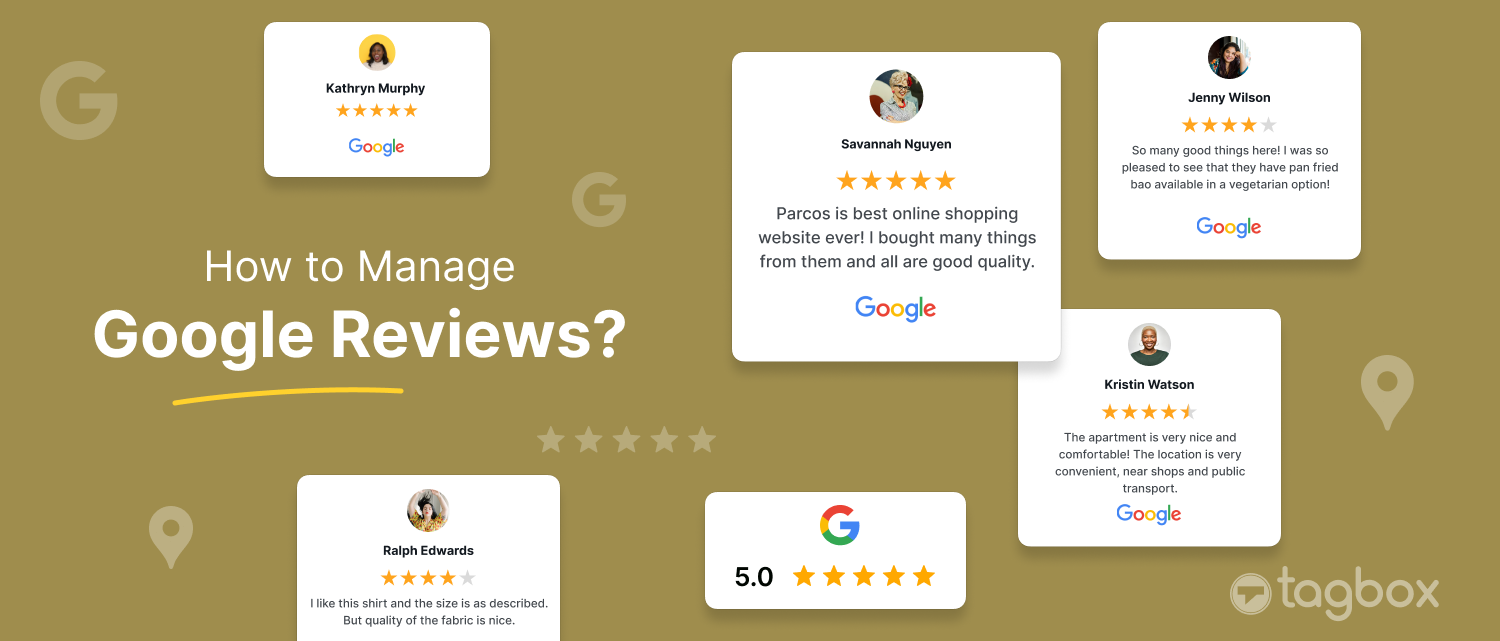Read summarized version with
Brands are trying to find innovative ways to get more and more reviews to enjoy the benefits that come with it.
Getting reviews on Google can be hard, but managing the reviews is a whole other thing. So many things are to be taken care of while managing Google Reviews. Therefore, automating these reviews can save a lot of time and resources.
You can automate various processes such as responses to reviews, review monitoring, sending review requests, etc. Here is everything you need to know about Google Review Automation.
What are Google Reviews?
Google Reviews is a review platform introduced by Google where users can share their experiences after using a product or service. More reviews benefit a business in many ways, such as higher ranking, building customer trust, increasing brand reputation, etc. It is very important for a brand to properly manage these reviews to get the most out of it.
What is Google Review Automation?
Google Review Automation is a process of using automated tools to manage Google Reviews. These tools can perform tasks like sending review requests, responding to reviews, notifying you when you receive a new review, etc.
Brands can use these tools for various processes to maintain their online reputation and engage with their customers. Following are some of the processes that Google Review Automation can manage.
- Responses: Some businesses use scripts that automate the responses sent to the reviewers. They can respond to the reviews as per the nature of the review. Responding timely to reviews also contributes to increasing brand reputation.
- Review Tracking: Automation tools can also help a brand keep track of all the reviews being posted. Some tools can notify the brand whenever a review is posted on their profile.
- Reporting and Analysis: Automated tools can generate reports that the brand can use for future marketing decisions. The data gathered from these tools can be valuable for improving the strategies in use and identifying potential issues.
Collect and Embed Google reviews on Website [Auto-update] feature
Signup NowBest Google Review Automation Tools
1. Taggbox:
Taggbox is a Responsive Google reviews widget used for simplification of review collection and syndication. Reviews collected on this tool can be displayed on marketing fronts such as social media, web pages, and emails. Reviews can be integrated with all CMS platforms, email platforms, etc.

2. Podium:
It is a web-based tool that provides assistance to brands for brand reputation. Podium allows the brands to automatically respond to reviews given by customers.

3. NiceJob:
This affordable and efficient automation tool collects the highest ratings from the most satisfied customers. NiceJob is very simple to use and does not require any consultancy to set up.

4. BirdEye:
Being among the most widely used review automation tools globally, BirdEye is an expert in gaining customer insights. BirdEye is also used for connecting to potential customers via digital channels, resulting in a better conversion rate.

How to Automate Regarding Google Reviews?
The following processes in Google Review Management can be automated via automation tools.
- Choose the Perfect Tool: You must choose an automation tool that aligns the best with your brand. There are various tools available online that you can use for the same.
- Connect the tool to your Business Account: Connect your tool to your Google Business Account. This Step allows you to access the reviews posted by Customers on Google.
- Set up Review Request: Asking for review request at the correct time is very important as it increases the chances of the customer leaving a review. With an appropriate automation tool, you can automate the process of sending review requests. You can customize the message in the request to pander more to your audience.
- Set up Review Aggregation and Syndication: A good review automation tool can aggregate and display reviews on your dashboard. This eases the management and analysis of the reviews. You can also select and syndicate the best reviews on your marketing emails or social media by add google reviews to website.
- Configure Compliance Moderation: Automation tools are often also used to moderate the reviews and filter out the ones that seem fake or spam. These reviews can be flagged if they do not comply with Google Review Guidelines.
- Set up Alerts and Notifications: Businesses can set up automated notifications to inform whenever a customer has left a review. The alerts can be delivered via mail, notifications, or other communication channels.
Note: Embed Google Review on your website with Google Reviews Widget. Start a free trial and display your Google reviews now. Click below to try it for free:

Embed Positive Reviews on Website Automatically!
Try Taggbox and Embed Google Reviews on Website to increase trust and credibility.
Signup > It’s FREENo Credit Card Needed!
Why must you Automate Google Reviews?
Following are some of the major reasons why it is important for a brand to automate its Google Reviews.
- Time-Saving: Processes like data analysis, reporting, and review tracking take a lot of time if done manually. Leveraging automation testing services and tools can significantly decrease the time and effort required.
- Consistent: Consistency is always a good look at a brand’s reputation. Automation tools can help make the brand consistently respond to reviews, send review requests, and collect data. Having consistency while handling the reviews streamlines the entire process, making it more efficient.
- Reputation Management: Businesses can use automation to enhance their online reputation in the market. Responding uniformly and timely to reviews and gathering data to understand how to satisfy customers shows the brand’s commitment to serving its customers.
- Competitive Advantage: Businesses that can analyze their reviews via automation tools can gain valuable insights. Using these insights, brands can create marketing strategies to stay ahead of their competitors.
Why do Multi-Location Businesses Need to Automate Google Reviews?
Multi-location businesses can gain significant benefits by automating Google Reviews. Following are some of the reasons that make it essential for these businesses to go for Google Review Automation:
- Efficient Management: Handling reviews for multiple locations can be a daunting task. Automating the process streamlines the management of reviews across all branches. It saves time and ensures that no review goes unnoticed.
- Consistency: Review Automation ensures that the brand actively sends and manages review requests regularly. This results in a consistent online presence and reputation for the entire business, which is vital for maintaining trust and credibility.
- Prompt Responses: Automated tools enable quick and timely responses to positive reviews and negative reviews. This demonstrates the business’s dedication to customer satisfaction, potentially diffusing negative feedback and enhancing the customer experience.
- Insights and Analysis: Automation can aggregate and analyze reviews from various locations, providing valuable insights. These insights help in understanding customer sentiment, identifying common pain points, and making informed decisions to improve the customer experience.
- Local SEO Impact: An active online presence with a substantial number of authentic reviews can positively impact the local SEO of multi-location businesses. This helps attract more potential customers as businesses appear higher in search results.
Advantages and Disadvantages of Automating Your Google Reviews
| Pros | Cons |
|---|---|
| Automation streamlines various processes involved in review management. These processes might involve monitoring the nature of reviews and responding to new reviews promptly. | Lack of Personalization: Even after customizing the reviews as per their nature, it is not very difficult to differentiate between a human response and an automated response. |
| Automated responses and review requests make sure that the processes are working with a consistent approach. | There can be instances when the automation tools cannot understand the exact nature of the review received. Sending irrelevant responses to a customer confuses them and can negatively impact your brand reputation. |
| Review automation allows quick responses, which shows that the business is committed to customer satisfaction. Brand responding to customer reviews makes the customer feel heard. | Automated responses might not effectively address the issues raised by the users in their reviews. The response sent by the automation tools might understand the nature of the reviews but the response might not be appropriate. |
| The information the automation tools provide, such as reports and analysis, can be valuable in developing new marketing strategies. These insights can be used for competitive advantage and help identify potential risks and threats to your business. | Relying heavily on automation tools can detach you from understanding the actual customer experience. Therefore, there might be some valuable feedback. |
| The scale at which the review management can be done in less time increases significantly with automation tools. Increased scalability also allows the brand to reach out to more potential customers, which might increase traffic. | Automating responses can be challenging if your brand works in different nations, as reviews can be in different languages. The tools might not understand the language in which the reviews are posted, making it difficult for the tool to respond. |
| With automation, reviews can also be categorized as per the Google Ratings and the overall nature of the review. | The cost of installing and using some automation tools can be very high, making it difficult for small-scale brands to use them. |
| You can tailor your automated responses as per the nature of the review. You can start by appreciating if the review is positive and acknowledging and apologizing if the review is negative. | Even to resolve the above issues, maintaining a review automation tool can be very complex. Fine-tuning the tool to ensure effective responses can be very time-consuming and can backfire if not done correctly. |
Wrapping Up!
Now that we have understood different aspects of Google Review Automation, you can decide what part of your review management you want to automate. You must consider the pros and cons before arriving at a decision.









